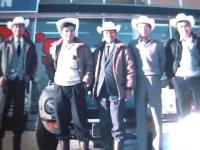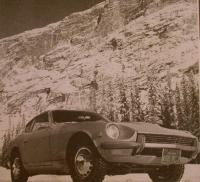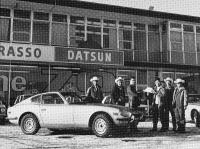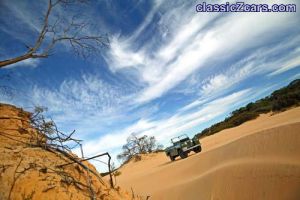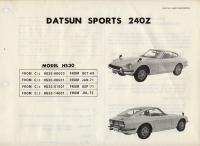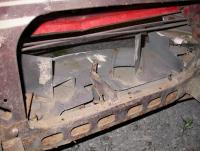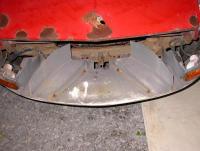Everything posted by HS30-H
-
Philosophical discusion on build dates
Hi 26th-Z, Here's the cine / video clip still photo - posted by Kats a page back or so on this thread - showing only the first two numbers "06" from one of the two cars from the initial test. I think it must be the initial test, as they are all wearing the white hats that they seem to have been presented with at the Datsun dealership. Kats' photo:
-
Philosophical discusion on build dates
Hi Kats, OK - so you think we can get pretty close to the true body numbers of Seisan Shisaku #14 & #15, but maybe not 100% certain? To summarise, Seisan Shisaku #14 & #15 might be HLS30-00004 & HLS30-00005 - UNLESS two "HS30" RHD Export models were made before October 1969 - in which case Seisan Shisaku #14 & #15 would be HLS30-00002 & HLS30-000003...... Realistically, those two possible "HS30" VIN-prefixed cars would have to have been made before mid September 1969 ( at least ) in order for their existence to impact on the Seisan Shisaku quantity BEFORE the two North American test cars were made and freighted over to USA in time for the first few days of October. Great stuff, Kats. Thank you. Alan T.
-
Philosophical discusion on build dates
Hi Kats, Yes - "Issu no Kotobuki" ( Kotobuki translates are 'felicitation' or 'congratulation', and Issu as 'seating' or 'chair' ) made many of the other FRP parts for Nissan too. They made most of the special parts for the ZG. Alan T.
-
Philosophical discusion on build dates
Kats, I can see that the number on the car from your video film-capture starts with "060" - so I'm wondering if its "060 ACJ"? In which case, the photo of the car with that number on it MUST surely be from the main test, and NOT the modified car that was sent over in late December by air? This is the same location / time as the other cine / video film that you took photos from - where they are all posing with their white hats. This shows two cars, and not one - so it must be the main test. Those "2177" numbers must have been issued temporarily, and they changed to the other numbers - one of them "060 ACJ" during the test. Alan T.
-
Philosophical discusion on build dates
Hi 26th-Z, You might be counting the January to June 1969 6-month sub total as one extra production number? I read it this way: May = 1 Domestic, 1 Export June = 1 Domestic, 0 Export ( not 1 Export as you quote ) July = 2 Domestic, 2 Export August = 6 Domestic, 1 Export September = 9 Domestic, 2 Export ( so total 19 Domestic and 6 Export versions by the end of September '69 ). Alan T.
-
Philosophical discusion on build dates
Here's the "060 ACJ" plate pic. I'm still wondering if this is the 'modified' / updated car from December 1969, with all the improvements / alterations from what they learned in the tests? If not, it begs the question as to why its wearing a different California license plate?
-
Philosophical discusion on build dates
Hi 26th-Z, NMC = Nissan Motor Co. USA. Those "2177" plates appear to be Californian. Could they possibly be temporary issue for a limited-period import? You are right - now that I look at them they DO appear to have the same numbers on them, although I can't see the other digits too well. I was thinking that they could have used Japanese 'carnet' registration plates for temporary use in a foreign country - but of course that would only be possible of the cars had been registered in Japan FIRST. It seems certain that these cars were NOT registered in Japan - so that's why they could not use the carnet plates. Anybody know anything about temporary import use plates in California for the 1969 period? Why would TWO cars have the SAME number? Here's the pic of the "2177" cars:
-
Lanrover S2
Great photo Chris! Is this a 'Pro' shot? I'll look out for the mag when I go to the shops this evening.
-
Philosophical discusion on build dates
I agree - that was some drive. What an adventure. Looks like they didn't have too many car problems either - which is pretty amazing. However, we should remember that in some ways the 510 blazed the trail for the success of the Z in the USA / Canada. In some ways they would have known what to expect: In late 1967, Nissan's "Kaku U" group conducted a "Beikoku Yushutsu Tekigo Chosa" ( American Export Adapatability / Suitabilty Test ) with a pair of 510's. The 5-man team left from Los Angeles on October 30th, and drove more than 13,000km over a period of 38 days. They averaged 430km per day, at an average speed of 70km/h. I believe they got as far north as Fairbanks, Alaska. A large proportion of the test was conducted in Canada - with its cold temperatures - rather than further south with hot temperatures. Zedrally made a good point about Nissan testing cars in Australia from back in the Fifties. Don't forget that Japan's summertime temperatures can get very high indeed, too. In fact, Japan offers a great contrast in road types and terrain from north to south, and great contrasts in temperature and conditions between Summer and Winter seasons.
-
350z v 240z - Alan
Hi Gee and Halz, I was hoping it would take a bit longer for that issue to get published in your neck of the woods.......... I was misquoted! Honest! Actually, its been a salutary lesson in minding what you say and how you say it. Mick was writing things down as we chatted, but I certainly would not have said "240Z" when talking about all the first generation cars. And I certainly don't remember mentioning the name of Mr Burt Reynolds:ermm: He missed out one of the things we discussed at length, and I was really hoping he would point it out in an S30 / Z33 comparison. It was about the fact that the two models have mirror-image Handbrake Lever positionings; The S30 always had the lever on the RIGHT of the tunnel ( whether LHD or RHD ) and the Z33 always has it on the LEFT of the tunnel ( whether LHD or RHD ). I think this shows us something. We have discussed this ad nauseam on here - but I was hoping he'd point it out in the article. He didn't. Actually myself, Len Welch and Geoff Jackson were kind of an 'afterthought' addition to the article. The whole article was pretty much written and finished several months ago I believe. They borrowed the red 350Z from Nissan UK's press office along with their yellow 240Z press promotions car, and took them to Wales for photography. Nissan - I believe - had told them that they were the first to get the two press cars together for a magazine article, and C&SC would have an 'exclusive'. Then their rival 'Classic Cars' Magazine brought out their January 2004 issue with a Photoshopped version of Nissan UK's yellow 240Z ( they changed the colour and put the number of another car on it because they did not want two consecutive cover cars in yellow! ). So the C&SC article was put on the back-burner for a while. Mick then revived it and did a little bit of re-writing, plus the addition of the 'interviews' with the three of us. Mick didn't want to take a photo of the ZG that showed too much of it. He said he wanted to 'save' it for a full feature at a later date. I would have preferred NOT to have my photo taken, frankly! He made a few errors in the text, but I was very glad he made the point about Goertz and Matsuo - which was not from my prompting, by the way. He also made a point about that in his Editorial column elsewhere in the mag. What did you think of the comparisons he made between the two cars? I got the feeling that he didn't really rate either of them all that much, which was a pity. Cheers, Alan T.
-
Philosophical discusion on build dates
Hi Kats, Does this mean that Seisan Shisaku #14 & #15 were HLS30-00014 and HLS30-00015? Or were the Seisan Shisaku cars not numbered? Or were they other ( lower? ) numbers of HLS30 bodies? There are lots of secondary questions that would lead on from your answer. I'm still confused about the quantity of cars that did the cold weather tests in USA & Canada. From the pictures I have seen, I can identify THREE different California registration tag numbers. Alan T.
-
European Spec 260z 1978 Would it have a crossover bar and EGR system?
Hi Oliver, When you say "European Spec" do you mean UK-market ( RHD ) or LHD continental European market? You say that you are trying to return your car to original spec, so I presume that you do not currently have the EGR stuff installed? What's the VIN, and can you provide any other data? If its a UK-market RS30 then the spec details can be very hard to pin down accurately for each individual car. I have seen all sorts of confusing anomalies on these cars. Cheers, Alan T.
-
Philosophical discusion on build dates
Hi 26th-Z, I feel like I have to be careful when discussing the LHD cars, and especially careful when putting forward any thoughts that might be seen as the equivalent of blasphemy A couple of quotes from the article you mentioned jump out at me as worthy of question: *"According to Nissan Motors, they usually do not release any of the first twenty to twenty five cars produced, when starting the assembly of a completely new model". Well - this calls into question what Nissan would include in that first twenty to twenty five cars produced. We know that some very low number HS30 models made it out of the Factory and were sold to the General Public, and surely you would think that the difference between the LHD and RHD 'Export' models might be enough for Nissan to include some of the RHD Export models in that 'first 20~25'. Moreover, you would expect that the Domestic-Market models ( which we KNOW were produced in higher numbers than the LHD Export versions during 1969 ) would have to be included too - if not indeed getting their own 20~25 cars for R&D / crash testing etc. I would have thought that the Domestic cars could even be subdivided themselves ( between S30 and PS30 prefixes ) as they were different enough from eachother to warrant different post-build inspection and even different crash testing etc? I don't personally know any super low-number VINs for Japanese market cars, although I HAVE seen PS30-00013 in the metal ( it still exists ). *"Rumor has it that #00009 - #00015 were sent to Nissan Canada for cold weather testing. These cars were not completed production units - but rather were test mules." If these cars were numbered as quoted, then I wonder if they are the same cars that appear in the photos of the USA / Canada testing runs that we have discussed in the past. Those cars were very clearly not the same spec as the first of the production models that were delivered to the public for sale, and not even - seemingly - the same spec as nos 00007, 00008 & 00009 which still exist and are well known in the USA? There is some conflict in this information. I agree with you that if Nissan quoted HLS30-00013 in the R-Drive book that there is a very good chance it made it outside the Factory - and may have been sold to the general public. Certainly if you cross-reference this with the fact that HS30-00003 is quoted in the R-Drive parts book for the RHD Export cars, and we know that this car was indeed sold to the general public, then it might well hold true. Our "Part Number One" discussion still fascinates me. I agree that a 'White Body' or spare bodyshell WITHOUT a stamped VIN number would have to be classified as a spare part, but spare unused bodies WITH complete VIN numbers DID make it outside the Factory. In some respects, I find myself unable to shake off the feeling that such a bodyshell has a firm identity and needs to be included in our discussions - if only to establish that such a number existed. Alan T.
-
What's wrong with this picture?
Sorry - I don't think I can be of much help on this one. I can give you part numbers from the Nissan R-DRIVE parts books, but not specific details on what was fitted when, or what side the tuning knobs were on for each particular market. However, its clear from the parts books that there were 4 different radios for the early cars ( two types of Auto-Tuning version, one ordinary 5-button and one AM-FM especially for Europe ) and also two versions of the combined radio / 8 Track tape player....... All of the above were listed as 'Optional Equipment' for the UK / European market. I'm sorry - I don't know what Hitachi model numbers the above-mentioned part numbers relate to. I don't have that data. I don't even have one of the push-button radios for the ZG. I have the original radio / 8 Track - but its not installed in the car - its buried deep inside my garages somewhere - so I'm afraid I can't confirm on which side the tuning knob is located. Do you think they really made RHD and LHD versions? I can type out those part numbers if you think it might help - but I don't know what you are going to cross-ref them with? Alan T.
-
Philosophical discusion on build dates
Yes - the Nissan 'R DRIVE' parts books are really useful and informative. The question is - just how accurate are the numbers they show for engines and body numbers? If you believe the one for the 'Export' HS30 ( RHD model 240Z ) then HS30-00003 was "from Oct-69".......... Here's a scan of the relevant page:
-
Philosophical discusion on build dates
Hi 26th-Z, An S30S is Z Genesis S30S = "ZS" = Z Standard. Your basic 'cooking' Z. No carpet, no hubcaps, no bumper trim, no rear demist, no clock, no radio, no frills, no mention on zhome.com ( poor thing ). You didn't take my bait about the L20 engine having no VIN prefix denomination letter. Spoilsport. Maybe you knew what was coming. :tapemouth
-
Philosophical discusion on build dates
Maybe this is getting back to the 'philosophical' slant to the original thread, but I just can't bring myself to accept that when that 'OK' sticker hit the window is when the car was 'born'...... Personally, I tend to think of the real 'birth' of the car somewhere further back up the line. Don't know where exactly, but sometime around when it got its own unique VIN / body number combination is - I feel - when it at least started to become an individual car. 'Course, it wasn't a whole car at that time.......
-
Philosophical discusion on build dates
What model got the "HR" prefix? There was no letter designation for the L20 engine. Guess why. VIN prefixes for Japanese-market cars were as follows: S30 ( for S30 / S30A / S30S / S30SA ) PS30 ( for PS30 and PS30SB ) HS30 ( for HS30 / HS30S / HS30A / HS30SA / HS30H / HS30HA ) .....and then RS30 / GRS30 / and S31 etc etc.
-
Kpgc110 Gt-r
Lachlan, You are misinterpreting it, mate. He's making the point that its NOT the usual GT-R replica, but that its a GENUINE GT-R. Its a corker isn't it? Alan T.
-
Philosophical discusion on build dates
I don't know that much about the HLS30 cars, that's all. I don't know very much about the Technical Service Bulletins for the USA / North American market either. At least not as much as some of the posters on this thread. Better to ask one of them. I reckon its a typo or just a plain mistake. I've never heard of two production lines or two production runs. As far as I am aware, there was only one production line and whether a car was Automatic transmission or not was NOT discernible from the VIN number - they were just given body numbers in sequence with all the others in their same VIN prefix group. Alan T.
-
Location of the ZG cars?
Hi Lachlan, U in HLS30U = USA. Or at least USA and Canada. Or North America....... You've not seen that before? Nissan had a code for all our cars. Sometimes more than one. Yes - I go into Autoresponse mode with regard to the ZG.:classic: Alan T.
-
Location of the ZG cars?
You mean Mr K's car? That car was / is NOT a ZG. Please don't call it the "American marketing version of the ZG". I have no idea - other than the fact that it was once Mr. K's personal transport - why NMC USA chose to use it for promotional purposes. As far as I understand it, the car was a standard HLS30U and some other parts were added privately, including wire wheels. Whether the front end parts were genuine Factory parts or not - putting them onto a car does not automatically make that car a ZG. Only Nissan could make a genuine ZG. If a car left the Factory as a genuine ZG then - theoretically - you could take all the ZG-specific parts off it, and it would STILL be a ZG. That process does not work in reverse. Alan T.
-
Japanese style intake induction system
Hi Gav, That car was at the Club S30 / S30 Owners Club joint meeting at Sagamiko Picnic Land in Kanagawa which I attended late last year. I took some photos of it and put them in the Gallery section for that event: http://www.classiczcars.com/photopost/showphoto.php?photo=7784&password=&sort=7&thecat=551 http://www.classiczcars.com/photopost/showphoto.php?photo=7802&password=&sort=7&thecat=551 http://www.classiczcars.com/photopost/showphoto.php?photo=7803&password=&sort=7&thecat=551 http://www.classiczcars.com/photopost/showphoto.php?photo=7796&password=&sort=7&thecat=551 http://www.classiczcars.com/photopost/showphoto.php?photo=7804&password=&sort=7&thecat=551 I believe the owner's name is Mr Sato ( first name Tatsuya? ) and he's a member of the S30 Owners Club - if I remember correctly. He's using lots of Kameari Engine Works parts ( full counterweighted crank with LD28 stroke, Kameari steel rods with ARP bolts, Kameari pistons, Kameari camshaft, Kameari adjustable cam gear, Kameari twin idler cam tensioner ). That American damper he's using is made by ATI. His engine management is a MOTEC system supplied and modified by AVO ( AVO are a Japanese tuning company ). I believe his head is a welded and recut N42. He's had a few blow-ups, but he hasn't let it get the better of him. He's doing a good job. He's done a lot of the work himself, and the rest of the car is pretty trick too. It certainly drew admiring looks at Sagamiko. Cheers, Alan T.
-
Location of the ZG cars?
-
Location of the ZG cars?
That's not supposed to be a 'web-page' as such. Its just a free place to store photos online and link to them - which can be useful sometimes. I don't normally send people there without a reason to do so. I don't think of it as my Homepage or anything like that.... Yes - the baffles / ducts in the lower pan of the G Nose were an attempt to channel air more efficiently for the air conditioning systems. The first run of HS30-H's never had them ( my car is one of these ) so you could think of them as early / late - or 'Series 1' / 'Series 2' if you like. The baffles / ducts were made from FRP ( not aluminium or steel, as some people seem to think ) and were attached to the lower pan by nuts and bolts. Here are a couple of pics of a real ZG in Japan, in a rare state of undress. They are useful for showing the shape / form of the genuine lower panel as it is when attached to the car:





